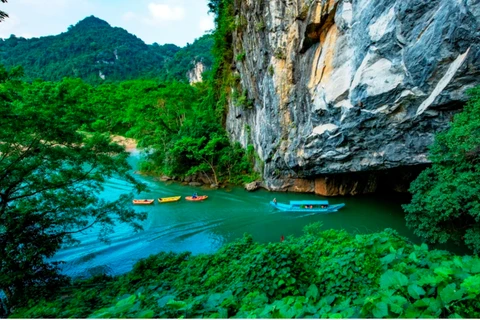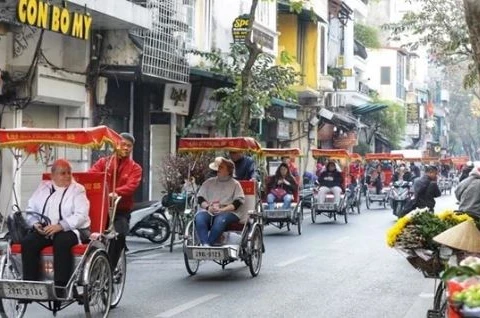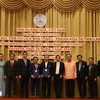Hanoi (VNA) – Public-private partnership has been defined as the ‘golden key’ for the tourism sector to recover and secure sustainable development after the COVID-19 pandemic.
Vice Director of the Vietnam National Authority of Tourism (VNAT) Ha Van Sieu granted VietnamPlus an interview on the significance of the public-private partnership in the industry.
Reporter: We can see clearly that after the COVID-19 pandemic, many tourism operations are no longer effective. In that context, the public-private partnership has become the solution that many localities choose to promote, restore, and develop the industry sustainably. So how do you assess the importance of the this “key” solution?
Mr. Ha Van Sieu: After the COVID-19 pandemic, tourism has changed, prompting the sector to make changes for recovery and sustainable development. The public-private partnership is significant and crucial as a path that localities and destinations must follow.
However, destinations are considered shared assets, while services belong to each supplier. So what will cooperation be like to ensure that destinations shine and businesses attract customers?
As we can see, in the tourism sector, although many suppliers or localities have shown strong performance, a single incident can ruin all of their efforts.
We have called on businesses to coordinate with destination management agencies to take specific actions, strengthen the application of technology and implement public-private investment programmes as well as other programmes to develop human resources and promote the destinations.
It is necessary to mobilise resources from enterprises, together with the State, to solve common problems with the same purpose. For example, if destination management agencies launch a promotion programme, local businesses must respond to it by contributing their resources and introducing products. Whether a destination can shine depends on whether the tourism products of the businesses are of good quality or not. This is also a specific content of the public-private partnership.
In particular, promotion programmes bring practical benefits and a "win-win" balance to all stakeholders.
Therefore, we highly appreciate management agencies that exert efforts to mobilise the engagement of businesses. There are many small and medium-sized enterprises that do not participate in the process of promoting destinations, so it is unfair if they benefit in the business that the destination brings. It is not required by law, but in reality all parties must participate in the process if they want to benefit for mutual development. That is the principle of the public-private partnership in tourism promotion.
Some localities have set up a fund by mobilising resources from private firms to support State agencies to step up promotion and human resources training. All of this content should be optimised in the public-private partnership to ensure that businesses and State agencies enjoy similar benefits.
Reporter: In terms of foreign tourists, we have completed the target for the whole year in only 10 months. What do you expect about the growth in the number of foreign visitors in the coming time?
Mr. Ha Van Sieu: We set a target of welcoming 8 million foreign tourists in 2023, but after 10 months, we have seen 10 million visitors. This is obviously a great result. However, these are just numbers. We expect a lot in terms of tourism quality and visitors’ experiences at Vietnamese destinations, and in terms of what is different and what is new and more interesting than before.
This recovery speed is also in the common trend of the region and the world that we have been keeping up with and step by step working with investors, businesses, communities, and tourism associations to adapt to greener and better quality tourism trends, meeting the needs of visitors after the COVID-19 pandemic.
The whole industry is focusing on the trend of green investment and responsible experiences from visitors’ interaction with destinations. Here, the issue of tourism quality is put in the top place with the hope of encouraging tourists stay longer and have more special experiences and impressions.
Therefore, tourism products must be designed to spotlight values that meet the demand and taste of tourists and ensure that they have the most experiences so that they can stay longer, or so that the choose to return in the future. This is a sustainable investment direction. At the same time, the sector must renovate itself with the stronger application of technologies in connecting destinations in tourism products.
The number of 10 million visitors recorded in the first 10 months of this year is encouraging businesses to continue to offer better services and professionalism. The tourism sector needs to team up with other stakeholders, while applying technologies to bring a new face to tourism quality and competitiveness, meeting the requirements in the new period.
Reporter: According to statistics, up to 70% of international visitors to Vietnam travel to the sea and islands, and this is also the strength of Vietnamese tourism. In your opinion, in the coming time, should we continue to invest in this direction to attract more foreign visitors?
Mr. Ha Van Sieu: Vietnam has advantages in sea and island tourism and is on the right track to optimise this advantage. Before the COVID-19 pandemic broke out, we drew a large number of tourists to beautiful beaches, but after the pandemic, we should restructure and re-calculate the way we operate tourism activities, thus making the national tourism more attractive not only for beautiful sea and islands but for culture.
In a wider meaning, culture is the tradition, heritage and local value that communities have, forming part of activities that tourists can engage in and interact with, thus giving them an in-depth impression and insight into the destination.
It is clear that we have advantages in maritime tourism and traditional culture. If we can turn them into cultural experiences for tourists, they will stay longer, and this would enhance the value of the destinations. I think we should go this way.
Reporter: Thank you very much./.

























